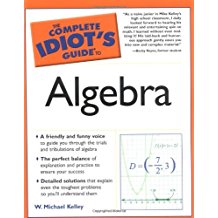Algebra: Area and Volume Problems
Area and Volume Problems
Algebra teachers have a lot of weird tendencies. For one thing, they love fractals. I don't think I've ever met a math teacher who didn't have a poster featuring fractals proudly displayed in either his or her classroom, office, or wallet, next to pictures of his or her children. (In case you don't know, fractals are geometric shapes that look the same at any magnification. In other words, if you zoom in on the shape, its tiny detail looks just like the bigger shape. Practically speaking, a fractal usually looks like a psychedelic and groovy squiggle that should be featured on a tie-dyed T-shirt.)
Algebra teachers love geometric shapes so much, in fact, that they often ask you questions about them before you've taken a single geometry class. Don't be surprised if you see a few word problems regarding one of the following:
- Area. The amount of space covered by a two-dimensional object; the amount of carpet you'd need to cover a floor would depend on the floor's area.
- Perimeter. The distance around a two-dimensional object; the amount of fence you'd need to surround your yard equals the perimeter of your yard. (The perimeter of a circular object is called the circumference.)
- Volume. The amount of three-dimensional space inside an object; the amount of liquid inside a soda can represents the can's volume.
- Surface area. Measures the amount of "skin" needed to cover a three-dimensional object, neglecting its thickness; the amount of siding you'd need to completely cover a house represents the surface area of that house's walls.
There are lots of geometric formulas, most of which you'll learn in an actual geometry class. However, you may be expected to know the formulas listed in Table 19.1 by heart right now.
Table 19.1 Basic Geometric Formulas
| Description | Formula | Variables |
|---|---|---|
| Area of a rectangle | A = l · w | l = length, w = width |
| Perimeter of a rectangle | P = 2(l + w) | l = length, w = width |
| Area of a circle | A = r2 | r = radius of circle |
| Circumference of a circle | C = 2r | r = radius of circle |
| Volume of a rectangular solid | V = l · w · h | l = length, w = width, h = height |
| Volume of a cylinder | V = r2h | r = radius; h = height |
| Surface area of a cube | SA = 6l2 | l = length of side |
Basically, word problems in geometry come down to knowing the correct formula and plugging in values where they belong.
Example 3: (Inspired by National Lam-poon's Christmas Vacation) Uncle Eddie is nervous about sledding with Clark W. Griswold, thanks to the rectangular metal plate in his head. (As it is, every time his wife uses the microwave, he forgets who he is for a half hour.) During the operation to implant the plate, right before the anesthetic kicked in, Eddie remembers hearing the doctor say that the plate's width is 3 centimeters shorter than its length. If the area of the plate is 54 cm2, find its dimensions.
Critical Point
If a formula contains , leave your answer in terms of unless your instructor advises you otherwise. (In other words, your final answer should have 's in it.) For instance, the area of a circle with radius 5 will be A = · 52 = 25.
Solution: You know nothing at all about the length of the rectangle, but you do know that the width equals the length minus 3 centimeters, so write that expression algebraically: w = l - 3. Because you know the area of the rectangle, you can then set up an equation based on the formula for rectangular area.
- A = l · w
Plug in A = 54 and w = l - 3.
- 54 = l(l - 3)
When you distribute l, you end up with a quadratic equation that can be solved by factoring.
- 54 = l2 - 3l
- l2 - 3l - 54 = 0
- (l - 9)(l + 6) = 0
- l = 9 or -6
You've Got Problems
Problem 2: The height of a certain cylinder is exactly twice as large as its radius. If the volume of the cylinder is 36 in3, what is the radius of the cylinder?
One of these answers doesn't make sensethe length of an object must always be positive, so throw out the -6 solution. You now know that the length of the rectangle must be 9 centimeters. Plug this value into the expression you came up with for width to determine the other missing dimension (also measured in centimeters).
- w = l - 3
- w = 9 - 3
- w = 6

Excerpted from The Complete Idiot's Guide to Algebra © 2004 by W. Michael Kelley. All rights reserved including the right of reproduction in whole or in part in any form. Used by arrangement with Alpha Books, a member of Penguin Group (USA) Inc.
You can purchase this book at Amazon.com and Barnes & Noble.
